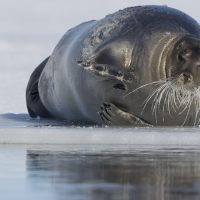This post is also available in: Swedish
Ivory gull – Pagophila eburnea
Ivory gull – Pagophila eburnea
is a small gull, the only species in the genus Pagophila. It breeds in the high Arctic and has a circumpolar distribution through Greenland, northernmost North America, and Eurasia. In North America, it only breeds in the Canadian Arctic. Seymour Island, Nunavut is home to the largest known breeding colony, while Ellesmere, Devon, Cornwallis, and north Baffin islands are known locations of breeding colonies. It is believed that there are other small breeding colonies of less than six birds that are still undiscovered. There are no records of the ivory gull breeding in Alaska.
During the winter, ivory gulls live near polynyas, or a large area of open water surrounded by sea ice. North American birds, along with some from Greenland and Europe, winter along the 2000 km of ice edge stretching between 50° and 64° N from the Labrador Sea to Davis Strait that is bordered by Labrador and southwestern Greenland. Wintering gulls are often seen on the eastern coasts of Newfoundland and Labrador and occasionally appear on the north shore of the Gulf of St. Lawrence and the interior of Labrador. It also winters from October through June in the Bering Sea and Chukchi Seas. It is most widespread throughout the polynyas and pack ice of the Bering Sea. It is also vagrant throughout coastal Canada and the northeastern United States, though records of individuals as far south as California and Georgia have been reported, as well as The British Isles, with most records from late November through early March. Juveniles tend to wander further from the Arctic than adults.
It sounds like this
Recording by Claire Mazard from Xeno canto






